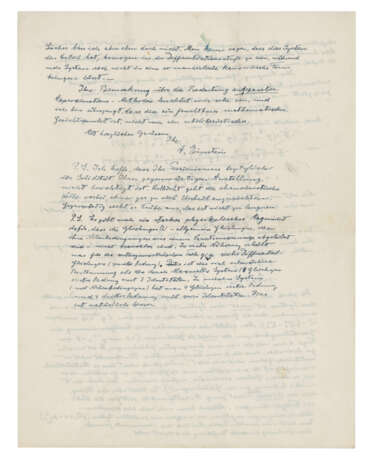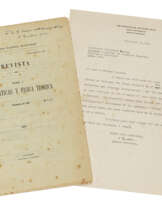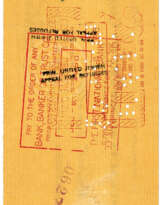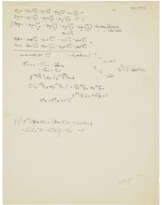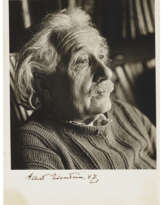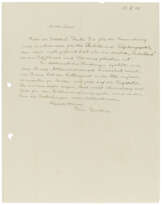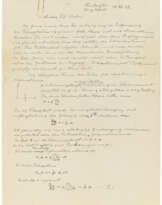ID 1109142
Lot 340 | Albert Einstein (1879-1955)
Estimate value
£ 8 000 – 12 000
Autograph letter signed ('A. Einstein') to Cornelius Lanczos, n.p., 18 March 1947
In German. Three pages, 279 x 216mm, on two leaves, including nine lines (one cancelled) of scientific calculations, with further terms within the text. Provenance: Sotheby's, 26 November 1980, lot 165.
A long scientific letter on gravitational field equations. Einstein thanks Lanczos for a letter (apparently of congratulations, perhaps on his birthday four days previously), but chides him for his 'excessive appreciation of my scientific efforts. As an old reader of Freud, I am afraid of the "father complex" that can so easily take hold with such an attitude'. Turning to scientific matters, Einstein admits that 'I don't like P-geometry after struggling with it 25 years ago. A major evil here is that one is forced to introduce a "cosmological term" which, according to the derivation, cannot be made 0. But then “flat space” was excluded as a solution (even in the pure gravitational case), which I find unnatural. I don't see any justification for the tensor, which is the geometrically simpler structure because you cannot get by with a symmetrical Γ-system. It is also not the case that the transition to Γ as starting variables would make it easier to restrict the choice of the Hamilton function'. Einstein goes on to focus on the 'real difficulty': 'As long as there is no possibility of enlarging the group, the field equations are largely arbitrary, since the symmetrical and anti-symmetrical parts transform without mixing. This is still the case, whether one chooses the g or the Γ as initial sizes (structure)'. Einstein provides the equation which seems to him the best starting point: 'These equations are the simplest ones that match with their hermetically conjugated counterparts'. He then restates the equations in accordance with the 'Hamilton principle (with real Hamilton function)'. Lanczos's suggestion of introducing 'quantities that correspond to the q and p of mechanics' brings in an old line of reasoning Einstein himself pursued: he sets out the equations and the two different forms which result from partial integration: but concludes 'I do not however believe that these are sensible equations', explaining his reasoning. In short, he has greater trust in the first set of equations: 'But the problem remains that the group alone does not provide enough clues for the choice of field equations'. In a first postscript, Einstein hopes that Lanczos's fears about losing his academic position are unfounded: 'Perhaps the chauvinistic wave is nearly over'. A second postscript returns to the mathematical argument of the main body of the letter, arguing that the second set of equations give a weaker outcome than that produced by Maxwell's system. 'In my system (with additional conditions) one has four equations of the first order and four of the third order with two identities. This is naturally better'.
| Artist: | Albert Einstein (1879 - 1955) |
|---|---|
| Place of origin: | Germany, Switzerland, USA |
| Auction house category: | Medicine & science |
| Artist: | Albert Einstein (1879 - 1955) |
|---|---|
| Place of origin: | Germany, Switzerland, USA |
| Auction house category: | Medicine & science |
| Address of auction |
CHRISTIE'S 8 King Street, St. James's SW1Y 6QT London United Kingdom | |||||
|---|---|---|---|---|---|---|
| Preview |
| |||||
| Phone | +44 (0)20 7839 9060 | |||||
| Buyer Premium | see on Website | |||||
| Conditions of purchase | Conditions of purchase |

